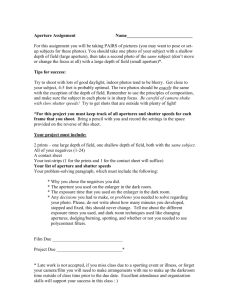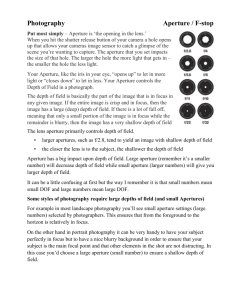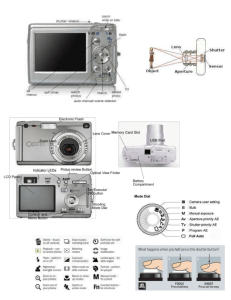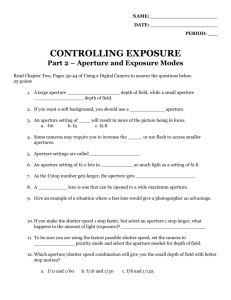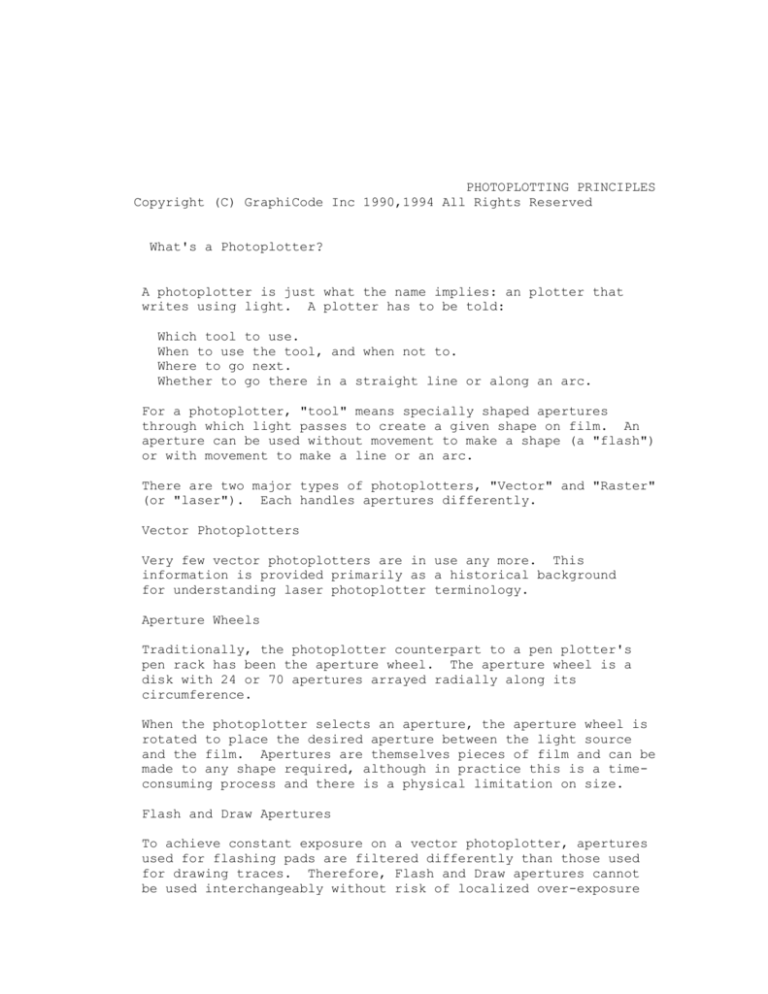
PHOTOPLOTTING PRINCIPLES
Copyright (C) GraphiCode Inc 1990,1994 All Rights Reserved
What's a Photoplotter?
A photoplotter is just what the name implies: an plotter that
writes using light. A plotter has to be told:
Which tool to use.
When to use the tool, and when not to.
Where to go next.
Whether to go there in a straight line or along an arc.
For a photoplotter, "tool" means specially shaped apertures
through which light passes to create a given shape on film. An
aperture can be used without movement to make a shape (a "flash")
or with movement to make a line or an arc.
There are two major types of photoplotters, "Vector" and "Raster"
(or "laser"). Each handles apertures differently.
Vector Photoplotters
Very few vector photoplotters are in use any more. This
information is provided primarily as a historical background
for understanding laser photoplotter terminology.
Aperture Wheels
Traditionally, the photoplotter counterpart to a pen plotter's
pen rack has been the aperture wheel. The aperture wheel is a
disk with 24 or 70 apertures arrayed radially along its
circumference.
When the photoplotter selects an aperture, the aperture wheel is
rotated to place the desired aperture between the light source
and the film. Apertures are themselves pieces of film and can be
made to any shape required, although in practice this is a timeconsuming process and there is a physical limitation on size.
Flash and Draw Apertures
To achieve constant exposure on a vector photoplotter, apertures
used for flashing pads are filtered differently than those used
for drawing traces. Therefore, Flash and Draw apertures cannot
be used interchangeably without risk of localized over-exposure
and under-exposure.
Aperture Wheel Setup for Vector Plotters
The setup of an aperture wheel is an exacting and time consuming
process since each aperture in the wheel must be hand-mounted and
aligned. In order to avoid repeated setup costs, designers have
the photoplotting vendor keep a wheel on file and are forced to
always use that same set of apertures. This has obvious
drawbacks, both in terms of design flexibility and the ease of
migration to other vendors.
RS-274D files were not designed to communicate any information
about the apertures in use, only to specify where they are used.
This has led to a great deal of confusion between designers and
fabricators since designers aren't aware that a Gerber file alone
in not sufficient to define the board - an external document
describing the apertures is also needed.
Raster (Laser) Plotters
Aperture Lists
Increasingly, vector photoplotters are being replaced by the
laser photoplotter, which emulates the older style machine in a
raster (bit-map) fashion. While use of the term "aperture" to
describe a pad or trace shape persists, the term "aperture wheel"
is now being replaced by "aperture list", which implies the
greater flexibility now available to the designer.
There are four principle advantages with aperture lists on
raster plotters:
1. Aperture shapes can be easily generated in software, thus
eliminating the need to design a physical wheel.
2. The aperture shapes can be described in the Gerber file,
if certain extended-Gerber formats are supported ("RS274X",
"MDA FIRE AutoPlot", etc). This reduces chances of getting the
wrong list.
3. More apertures can be defined on a list.
4. Allowable apertures sizes are typically (but not always)
greater than those imposed by the physical dimensions of an
aperture wheel.
Flash and Draw Apertures
No distinction need be made between Flash and Draw aperture types
since the light source intensity is constant.
Speed Advantage of Laser Plotters
Laser plotters operate much quicker than vector machines. A
complex plot that required hours on a vector machine can usually
be performed in ten minutes or less on a laser photoplotter.
This decreases turnaround time and in many markets has driven
photoplotting costs down.
Talking to Photoplotters
The de facto standard for photoplotter data is the Gerber format,
more properly known as RS-274D. The term Gerber refers to the
Gerber Scientific Instrument company, a pioneer and leader in
photoplotter manufacturing. Popular variants include Extended
Gerber ("RS274X") and MDA FIRE AutoPlot, both of which embed the
aperture list information in the file.
RS-274D is a variation on traditional Numerical Control (NC)
machine tool languages. It differs from traditional NC formats
(i.e. drill data), as far as its use of tool selection codes but
is otherwise compatible.
RS-274D data is organized in "blocks".
combination of codes:
A block consists of a
Tool selection
Setup
Movement
And, an End Of Block (EOB) character, which only follows a
combination of the above codes.
An EOB character is usually an asterisk ('*') or dollar ('$'),
optionally followed by a carriage return and line feed.
An RS-274D code consists of a letter D,G,M,X,Y,I or J followed by
a numerical value. These codes designate the following:
* - End of Block (end of command)
D - Select aperture, or set aperture use mode
X - Move to X value
Y - Move to Y value
G - Various setup codes
M - Various control codes
I - Relative X location for arc center
J - Relative Y location for arc center
D Codes
D codes have multiple purposes. The first is to control the
state of the light being on or off. Valid codes for light state
are D01, D02, and D03.
D01 - Light on for next move.
D02 - Light off for next move.
D03 - Flash (Light On, Light Off) after move (effect is limited
to block in which appears, ie non-modal). You can also think
of a D03 as D02, D01, D02 series of commands linked together.
D codes with values of 10 or greater represent the aperture's
position on the list or wheel. It is very important to
understand that there is no universal "D10" or "D30". Unlike the
D01 , D02, and D03 counterparts which have a fixed meaning (draw,
move, flash), D10 and higher values have aperture shapes and
dimensions assigned to them by each individual user. Hence, one
job's D10 could be a 10 mil Round, when another job's D10 could
be a 45 mil Square.
There are two distinct ways to number an aperture list. The
traditional 24 aperture system started with D10 - D19, jumping
suddenly to D70 - D71, then back to D20 - D29, ending with D72 D73. This is still a common format for output for CAD packages,
and is still mandatory for old 24 aperture Gerber vector
photoplotters.
It is now common to start with D10, then increase numerically in
steps of 1 (D10, D11, etc.) continuing up to D70 and beyond,
rarely beyond 1000 individual apertures.
X & Y Codes
The X & Y values in the Gerber file determine where the aperture
shape and dimension will be positioned and drawn. X & Y values
are used as coordinate pairs to determine where the light will be
exposed, using the D codes shapes (i.e. D10) and light exposure
status (i.e. D01, D02, D03) for drawing lines and arcs, as well
as moving between drawing entities.
Here are a few examples of using X & Y codes with D codes.
D10*
{ Select aperture D10}
X1000Y1000D02* { The D02 tells us that the light will be off,
and we move to coordinate position X1000 and Y1000}
X2000Y3000D01* { The D01 tells us that we will draw (light on)
to coordinate position X2000 and Y3000}
X5500Y100D03* { The D03 tells us to move to coordinate position
X5500 and Y100 with the light off, then flash (turn the light
on and off)}
G Codes
G codes are used to configure the photoplotter.
Commonly
implemented codes include:
G01 - Future X,Y commands are straightline moves
G02 - Future X,Y commands are clockwise arcs
G03 - Future X,Y commands are counterclockwise arcs
G04 - Ignore the rest of this block (used for Comments)
G54 - Prepare to change apertures
G74 - Future arcs are quadrant arcs
G75 - Future arcs are Full 360 arcs
G90 - Absolute data
G91 - Incremental data
Typically for laser photoplotters, G54 codes are not
necessary. Older vector plotter controllers may require this
preparatory G codes for changing apertures (i.e. G54D10*).
A common situation where G codes are mandatory for all machines
is when the data is switching from vectors to arcs and vice
versa. When switching from drawing vectors (G01) to drawing arc
(G02, G03), the controller must be informed of the change of
mode.
Another important case for G codes is when determining if the arc
is a quadrant (G74) or Full 360 (G75). Quadrant arcs never cross
quadrant boundaries, because the center coordinate offsets (I,J
Codes) are always unsigned (even if they are negative!).
Therefore, it requires at least four G74 arcs to draw one
complete circle.
Center coordinate offsets for 360 arcs (G75) can be positive or
negative, allowing for a single command to draw a complete
circle.
In either case, the center coordinates are given relative to the
start point of the arc. The most dramatic difference between
Quadrant and Full 360 arcs is that a Quadrant arc with identical
start and end points has a sweep of 0 degrees, whereas a similar
Full 360 arc is a full circle.
The G90 code tells the machine controller that all data following
is absolute data. Hence, if following X & Y data follows, the
controller will move to the absolute value given by the X & Y
value.
G91 tells the machine controller that all data following is
incremental data. The machine will move the data by the amount
of the X & Y value, rather than to the absolute coordinate point.
Example:
X1000Y1000D02*
X3000Y3000D01*
In absolute mode (G90), the machine will first move to coordinate
point X1000 and Y1000 with the light off, then draw a line to
coordinate point X3000 and Y3000 with the light on.
In incremental mode (G91) the machine will first move to
coordinate point X1000 and Y1000 with the light off, then draw a
line to coordinate point X4000 and Y4000 with the light on. This
was done by adding X1000 + X3000 = X4000 and Y1000 + Y3000 =
Y4000.
Here are some more examples of G code usage in conjunction with
X, Y, and D code values:
G54D10*
{ Prepare to change aperture position (G54), then
select aperture D10}
G01X1000Y1000D02*
{ Prepare to draw a vector (G01) then
turn off the light (D02) and move to coordinate position X1000
and Y1000}
G90*
{ This block (command) and all future commands will be
absolute data}
X2000Y3000D01*
Turn the light on (D01) and move to absolute
coordinate position X2000 and Y3000}
G91*
{ The G91 command tells the controller that
this command and all future commands that the data is
incremental}
X5500Y100D03*
{ Turn the light off and move incrementally
by a value of X5500 and Y100, then flash (D03) (light on and
off)}
M Codes
M codes are used for machine control.
used:
M00 - Full machine stop.
Here are the most commonly
Commonly ignored by many plotters.
M01 - Temporary machine stop.
Commonly ignored by many
plotters.
M02 - End of Plot.
I & J Codes
When you encounter an I & J code in a Gerber block, you have
found an arc command. Arc commands come in two flavors, Full 360
or Quadrant. The Gerber arc command is very complicated, and
this section will only briefly describe usage of the Gerber arc.
Full 360 arcs allow the plotter to draw a full circle (360
degrees of arc) in one single command..
Quadrant arcs only allow for an arc to be drawn through a maximum
of 90 degrees of arc, never crossing a quadrant boundary. Due to
this restriction, I and J arc center offset codes can get away
with never having a negative value, even if the offsets are
negative!
When in a Full 360 arc (G75), only one command is required to
draw a circle. In Quadrant mode, the same circle would require
at leaset 4 Quadrant arcs (G74), because a circle goes through
all four quadrants.
Quadrant arcs will
even if the center
center offsets can
negative I or J is
always have positively signed I and J values,
offset is actually negative. Full 360 arc
be signed positively or negatively. A
a sure indicator of Full 360 arcs.
Modality
It is often the case with Gerber data that when moving from one
XY coordinate point to another XY coordinate point, the X or Y
value will not change. Likewise, it is likely that if the
plotter is drawing a line with multiple segments, the segments
will be connected and the light stays on from segment to segment.
In both of these cases, there are redundant commands, making the
plot data file larger than necessary.
RS-274D allows you to omit this redundant data.
shows a box being drawn with four corners.
Non Modal Data
Modal Data
X0000Y0000D02*
X1000Y1000D02*
X0000Y1000D01*
Y1000D01*
X1000Y1000D01*
X1000*
X1000Y0000D01*
Y0000*
This example
X0000Y0000D01*
X0000*
From this example, a large amount of data has not been written,
thus reducing the final data file size.
Establishing the Decimal Point
A numerical value in RS-274D data has an integer and a decimal
part, but the decimal point ('.') is not a valid RS-274D
character. Thus, decimal values are written as a string of
integers. The implicit position of the decimal point is
determined by three parameters:
Number of integer digits (whole digits)
Number of decimal digits (precision)
Zero suppression.
For example: In a system with integer digits=n and decimal
digits=m (an "n,m" system), a numerical value is written using
(n+m) digits.
For example, in a "2,3" format the value 12.345 is written
"12345". In a "2,4" format, the same value is written "123450".
Zero suppression comes in three flavors - leading, trailing and
none. The idea of zero suppression is to reduce data file sizes
by eliminating unneeded 0 characters. The simplest and most
common form of zero suppression is leading zero suppression.
In a "2,4" format, with no zero suppression, the value 0.0100
would be 00 + 01000, written as "000100", but with leading zero
suppression the same value is written as "100".
With trailing zero suppression the same value 0.0100 would be
written as "0001".
How To Describe Data Formats
Gerber data and other XY languages use a standard method for
describing the data format. Two examples include:
"2,3 leading inch" or "3,3 trailing metric". The first number
specifies the whole digits used. The second parameter states
the precision. "Leading" and "trailing" pertain to the zero
suppression. And the last part of the description indicates
the units. Refer to the above sections if these concepts seem
unclear.


